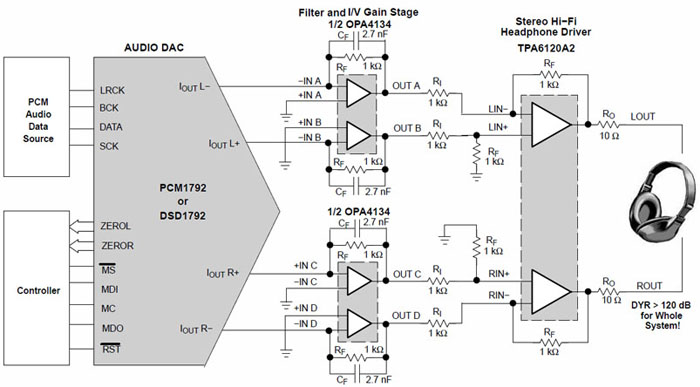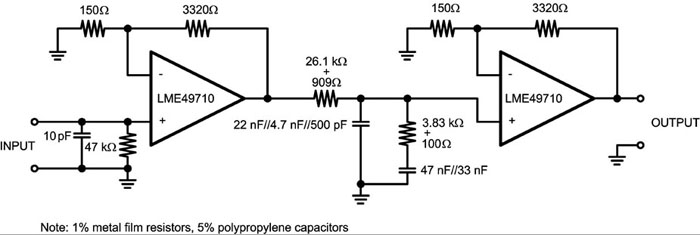Hi-Fi is an abbreviation of the English term "High Fidelity, " which in French means "High Fidelity", used in acoustics. Hi-Fi is a standard quality of a sound signal processing electronics.
. - What is a amplifier?
An amplifier is an electronic system that increases the voltage and / or intensity of an electrical signal. Considering the existence of a perfect amplifier, it does not distort the input signal and its output is an exact replica of the same frequency but phase shifted and amplified.
Electronic amplifiers are used in almost all electronic circuits: they can raise an electrical signal into a voltage read by the rest of the system.
. - How are amplifiers classified?
We classify the amplifiers into two families: the first takes into account the degree of amplification can find here the class A, B, AB, and C while the second is based on component technology: the If the D, G, H and T.
At first we introduce the class A, belonging to the first family and the D belonging to the second family.
Class A.
It uses only one transistor (biased) or tube to amplify the signal, it is very accurate and used most often for small signals or for low power applications that require precision (eg CD players).
Proper operation with regard to quality, however its performance is at best 50%, which means that in the worst case, a good half of the absorbed power is lost because this amp tends to heat and consumes very when its input signal is zero.
Class D.
The Class D amplifier is an efficient form of amplifier switch. It can grow until there 90% of its energy efficient, yet it generates more electrical interference than another amplifier configuration. This type of amplifier is often used in most electronic systems, including hi-fi system and the PA (public announcement). More and more companies are now producing this type of circuit but only a few have integrated audio CODEC with high performance. Do not forget that the "D" Class D not mean "digital" because the operation of the amplifier in class D is based on analog principles.
Since the class D amplifier non-linear, few products out several years ago have suffered low yield. During the past 50 years this perception of inferiority was eroded by advances in technological processes and technical drawings. Now the Class D amplifiers can be found in the home theater surround sound TV, LCD, audio systems and even car stereo amplifiers powered with battery.
Texas Instruments (TI) is recognized by industry as a major manufacturer of chipsets (integrated circuit packages) Class D, which offers circuits with different power levels and specializes in the field of consumer electronics (televisions flat screen, computer peripherals, portable equipment (car audio systems and external power amplifiers). To address these markets, TI has developed several families of class D amplifier with analog and digital inputs.
The market for portable devices, the family TPA2xxx, offers an amplifier with analog input that dominates the sector in terms of audio performance, yield, size and cost of the solution. Mono and stereo versions are available with power ratings of 1W at 2.75 W and a power supply from 1.8 V to 5.5 V. At the heart of the market for flat screen televisions, family TPA3xxx supports all power levels (from 5W to 40W), options to analog input and digital single-ended output and "dependent rise bridge. "
For the AV receiver market, TI offers a technology-input audio amplifier Pure Digital Pass ™ exclusive, with a capacity of 10 to 300W per channel. The TAS5261 provides single-chip Class D power level as high and delivers 110dB, a signal to noise ratio for sharper acoustics ultimate in home audio applications. It sends a 300W speaker of 4 Ohms and 125W can return into 8 Ohms, with 95% yield.
The new digital amplifiers for automotive IT digital audio amplifiers are class D, 4-way, ultra efficient. With moderate power levels, the amplifiers Class A / B provide, at best, a yield of 40-50% (25% in some cases). While TAS54x4 with amplifiers, TI offers 90% energy efficiency at normal listening levels for audio systems in the automotive segment.
Comparatively, two amplifiers can provide eight channels TAS54x4 while generating less heat than a system based on 4 channels in class A / B to a whole new class of economic systems Audio 8 channels, which are lighter, smaller and less Energy-efficient than existing systems. In addition, new digital amplifiers IT can also be used with 2ohm speakers to offer twice the output power in an amplifier AB 4ohms speakers, while generating less heat.
. - HEADPHONE AMPLIFIER LOYALTY
FEATURES
• 80 mW into 600 Ω ± from a supply of 12 V at 0.00014% THD + N
• Architecture-current feedback
• Noise output voltage of 5 to μVrms Gain = 2 V / V
• Power supply range: ± 5 V to ± 15 V
• 1300 V / us Slew Rate
• Differential inputs
• Independent power supplies for low crosstalk
• Short circuit and thermal protection
DESCRIPTION
The TPA6120A2 is a high fidelity audio amplifier built on a current-feedback architecture. This high bandwidth, the extremely low noise device is ideal for high performance equipment .. Solid design and performance of the TPA6120A2 ensure that the music, not the amplifier, is heard.
Three essential elements are the current-feedback amplifiers for outstanding audio.
The first characteristic is the high scanning speed which prevents the distortion weird anomalies order.
The second feature is in demand at the output that allows the amplifier to respond quickly and linearly when necessary, without risk of output distortion.
The third characteristic is the frequency response gain independent ¬ frequency that allows the bandwidth of the amplifier to be used on a wide range of gain settings.
. -NATIONAL SEMICONDUCTOR LME49710
A high performance operational amplifier audio PowerWise Familia.
Feature:
• Easily he led 600 Ω.
• Optimized for superior audio signal fidelity.
• Short-circuit output.
LME49740 operational amplifiers deliver an audio signal amplification for higher audio peak performance audio. The LME49710 combines the extremely low density of voltage noise (2.5nv / ^ Hz) and easily meets most uses of audio they require.
To ensure that the most difficult loads are driven without compromise, the LME49710 has a high slew rate of ± 20V/μs and an output current of ± 26mA. In addition, the dynamic range is maximized by an output stage which leads to less than 2 k ohms load is 1V supply voltage and within 1.4V with a load 600Ω. The LME49710 has a wide voltage range of ± 2.5V to ± 17V. The Audio Operational Amplifier AC achieved outstanding performance while driving complex loads with values up to 100pF.
Applications
• Ultra amplification audio de haute qualité.
• Préamplificateurs haute fidélité.
• Multimédia de haute fidélité.
• Haute performance audio professionnelle.
• Égalisation haute fidélité et les réseaux de croisement.
• Les filtres de haute fidélité active.
. - What are the advantages and disadvantages to use of Class D amplifiers over other technologies?
class |
A |
B or AB |
C |
D |
Benefits |
A single transistor |
distortion 2 transistors yield between 0.6 and 0.7 |
7 a single transistor |
2 or 4 transistors operating at all or nothing, high efficiency> 0.9, low birth weight. |
Disadvantages |
yield very low permanent |
mounting push-pull with distortion and no rest difficult to stabilize |
using narrowband |
requires a passive output filter developed |
Applications |
amp low power (<1W) |
Amplifier audio output stage amplifier AOP |
selective frequency multiplier |
amplifier audio, motor control
|

